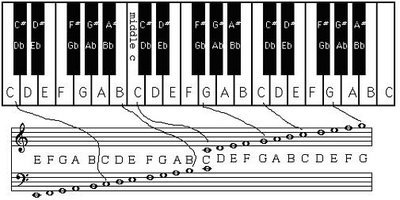Hi All,
Even before getting into any basics, I want to introduce the
General Scheme of WCM notations.
For many of you, this might have remained elusive the meaning of these symbiols. But it will not remain hereafter!
Let us have a brief encounter with these notations!
Kindly observe closely the following figure :

The above show a sample score sheet in “
Short-Score” format.
You can visualize the following :
Two sets of 5 lines called "
Stave" – Each set has
5 lines and
4 spaces in between.
There are certain black notes - a closed
black dot kind of thing which are attached with a
vertical line/stem either upward or downward as the case may be
Now concentrate on top 5 line.
Top 5-line starts with a kind of symbol
– This is called
Clef
– in this case
Treble Clef
– Indicates which part of key board the notes or belonging to
– in this case it denotes the high pitch notes (above middle-C) -
After the clef symbol, you see the
# symbol.
– This is called the
key signature
– it is written now on the 5th line in this treble clef
– This helps in fixing &
identifying the Scale (crudely Raagam equivalent) of the song
After Key signature, u can see letter
“C”
– it is called
Time signature
– it helps in
identifying the Time factor of the song
Then you can see the
notes written
– either on the
lines or in the space between (see the black dots - forget about the stem )
– each
denotes a particular note A, B, C etc depending on which line or space it is placed
In the top 5 lines of Treble Clef, if u further notice,
- there are two sets of notes are there – first set of notes forming the top line, with stem upwards
– the second set of notes with stem downwards forming the second line
- Each set is for one particular instrument (or voices), so 2 instruments covered (or 2 sets of voices)
• Are you clear of the top 5 lines contents ?
--------------------------------------------------------
Now concentrate on bottom 5 lines

Now it is easy to follow the same pattern for the bottom 5 lines also :
– the
clef symbol is called
Bass Clef
- Here also same
key signature, only line on which the # symbol is placed is different (4th line)
- Here also the same
Time signature , same "C" is there
- Here also notes placed on lines and in spaces
- Here also 2-sets of notes one with stem upward, other with down ward; these form the 3rd and 4th line of song
- Each set is for the 3rd and 4th instrument or voices as the case may be
------------------------------------------
• IF u r clear on the above points, now concentrate on following additionally derived and
summary of facts :

o There are 4–lines ie 4 instruments or
4-voices indicated, each having different notes to follow –
Two in Treble Clef and Two in Bass Clef.
o There is a big bracket covering the both Treble Clef and Bass Clef –
meaning all the notes of all the clefs are to be followed and sung simultaneously
o So all the 4-lines, ie 4 instruments/voices to sing/ play simultaneously
BUT ALSO IN SYNCHRONISATION with each other.
o So there is a
vertical relation / association between all the four instruments/ voices
– meaning when the first note of instrument-1 is played all the remaining instruments also play their part of first note and so on following the time pattern
o
This relation SHOULD NOT be missed and synchronization maintained – which is the job of music Conductor
o So the
Vertical relationship as well as Horizontal relationship of notes
is what forming the HARMONY,
which SHALL FOLLOW CERTAIN RULES ! (
Hundreds of it …..!)
o Usually the very first top line is what u call as melody line which the Singer sings and other 3 are using instruments or again voices.
o It is not necessary that all the time all the 4 lines )we call it 4-parts) are must for
Harmony, it may be 2-part or 3-part or 4-part .
o BUT whether 2 or 3 or 4-part Harmony,, the Harmony RULES MUST BE FOLLOWED in music composing !
IR religiously follow these Harmony rules in every micro-seconds of his MUSIC ! 


